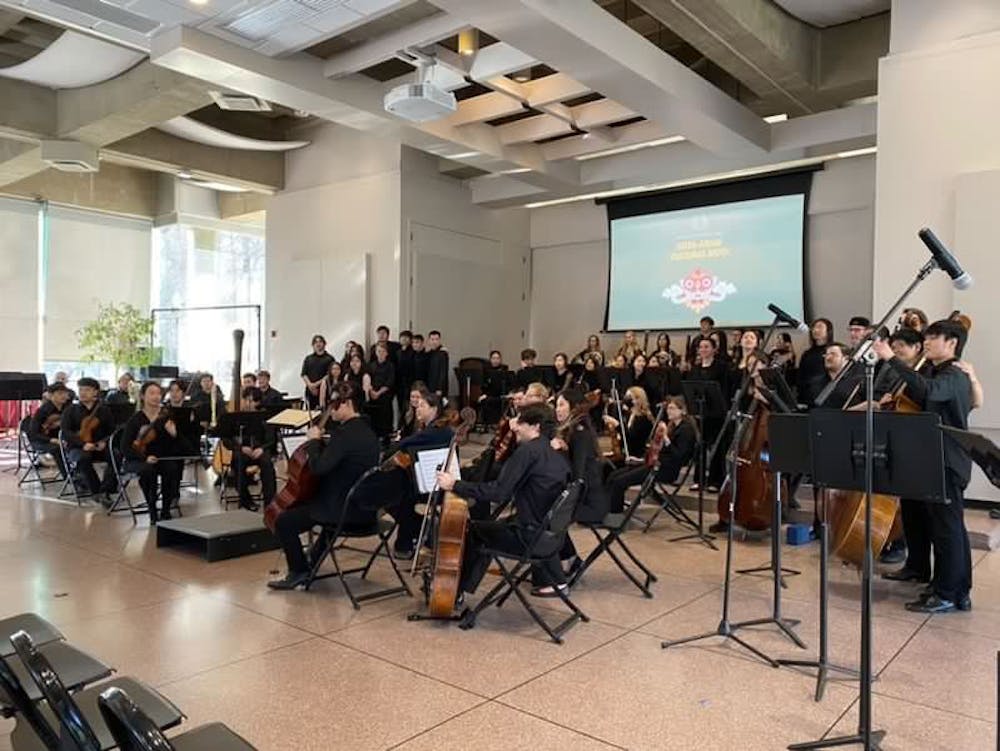Held at the Glass Pavilion this past weekend, The Inter-Asian Cultural Expo (IACE), curated by Ryo Hasegawa, showcased both visual and performance art from Asian students across Homewood Campus, Peabody Institute and the Maryland Institute College of Art.
To start off, I attended the beautiful solo performance by Yuehan Liu with the guqin, an ancient Chinese instrument played horizontally with seven strings. After her performance, Liu explained that the song she performed, translated to “flowing waters/spring,” is one of the most popular songs for the guqin in China. The instrument has a truly beautiful and unique sound that allows for full modulation: with a gentle movement, the strings can let out long, modulated notes full of longing and serenity.
Notes of Ranvier, an a capella group at Homewood, took the stage next. Their songs featured strong solos from senior Raven Foster and sophomore Faith McCarthy, which served as a cool introduction to the many musical performances to come.
The next “performance” — or, rather, lecture — was conducted by Dany Chan and Ani Proser, curators of Asian art at the Walters Art Museum. Their new exhibition, opening April 23, is titled Across Asia: Arts of Asia and the Islamic World, featuring connections between different Asian cultures.
Chan discussed the arts of Korea and Japan, showcasing various ceramics and functional tea set items. She likened the styles of ceramic to a sugar jar found in France and showed the striking resemblance between the small monkey sculptures found in both East Asia and Russia. Proser’s talk focused on south and southeast Asia, connecting various Hindu sculptures and idols.
According to Proser, another theme of this exhibition was scholarly work and the interaction between contemporary experience and past traditions.
In an interview with The News-Letter, Proser detailed the process of putting together the exhibition.
“There’s still many things in the database that don’t even have any images there, so we literally had to go into storage and look at them in person,“ he said. “We just found these incredible treasures we didn’t even realize were part of the collection.”
Chan described how the curators choose which objects to include in an exhibit in an interview with The News-Letter.
“Once we have a list together, we look at all the objects and see what stories organically emerge from them. If an object didn’t really fit into a story that we wanted to tell... then that’s one reason to say no to it,” she said.
The lecture added an insightful aspect to the expo, which had only showcased East Asian art in the previous year. This year, the theme of inter-Asian influence was highlighted both in the lecture and the art.
After the lecture, I walked to the Great Hall to look at the stands set up for individual, visual artists, which included sketches, prints, comic books and photos. Photographer Vie Auren showcased a unique group of pieces, such as edited portraits, Spotify playlists and a beautifully stylized newsletter with a multi-page poem. Their work underscored the internalized perspective on gender identity and family trauma.
In the last performance of the entire expo, IACE Orchestra, conducted by Hasegawa, took the stage. The last two pieces included a choir part by the Notes of Ranvier.
Peabody graduate student Jonathan Shin wrote the first piece, titled The Night Bazaar. The piece was based on Shin’s experiences growing up in Singapore and attempted to capture the energy of the night bazaars that celebrate the melting-pot culture of the area. As Shin described in his introduction, the music moves from a “boy theme” to a “military theme” and then melds together. The piece was full of energy; the strings were incredibly tight and focused, and I was amazed at how the musicians immediately seemed so in tune with one another.
The set then moved to The Golden Age Flute Concerto, written by Taiwanese composer Chi-Yi Lee. Peabody student Lily Xie performed the flute solo, displaying an expert sense of rhythm and blowing through incredibly complicated melodies. Her mastery of the instrument was very moving and paired well with the rest of the orchestra. On one occasion, I even saw some of the bassists smile as they engaged in an energized call and response with Xie.
The Notes of Ranvier performed the final two pieces. The first had the choir humming and drawing out long notes to back up the lyrical melody of the rest of the orchestra. In the final piece of IACE, Hasegawa encouraged the crowd to clap along to an energetic, big-band-style composition with Latin influences, featuring a prominent trumpet and drum set. Several solo lyrics emerged from the choir, and clapping musicians and audience members alike brought IACE to a triumphant close.
Overall, the second annual IACE brought various cultures together to celebrate the traditions and contemporary modes of art in all its most beautiful forms.





